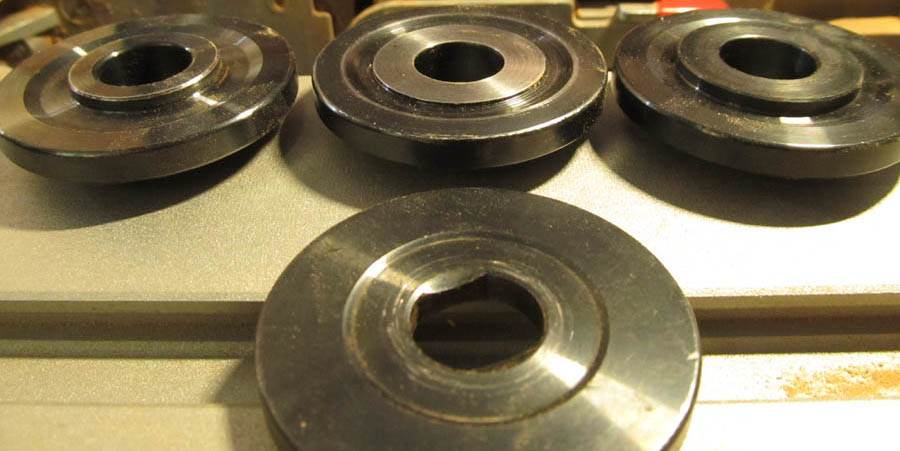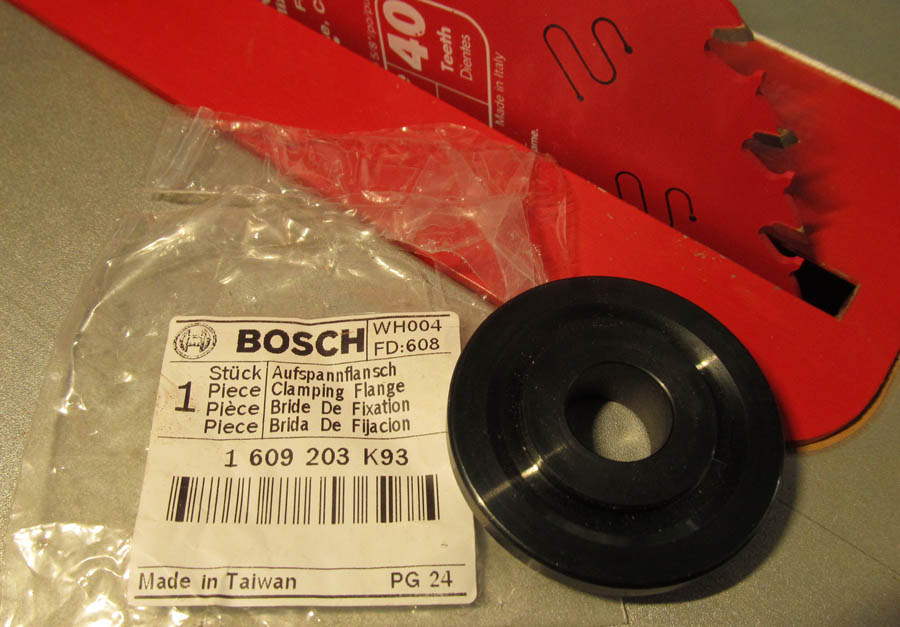Bosch GTS10J Mods
Arbor Flanges
After two attempts to get the right part, i eventually received a pair of 30mm bore flanges that fit the GTS10J. The flange that was ordered locally has still not arrived after 4 months. The ones ordered from ebay came in about 6 weeks each. Note that the parts diagram contains errors, and you want the flange part number 1609203K93, which is the 30mm collar version supplied to the majority of non-US regions. To be honest I get the impression that the Bosch parts systems is a bit chaotic just now.
Of the two flanges I received, one was kept for 30mm blades, and the other was machined to fit 5/8" blades. Note that the 30mm flanges have an inner diameter that is 0.1mm looser fit than the original, and all three flanges have that basic 0.02mm flatness/run out.
My plan was to get a friend with a lathe to do this, but one rainy sunday, i decided to go at it with the angle grinder and a dremel, being super careful to not touch the actual flange surface. By using a drill press to spin the flange this worked tolerably well, and the collar was machined just below flush thus leaving the maximum bore depth. And presto, the 5/8" Diablos fit on the arbor just perfect. There's still a little blade wobble in the order of 0.03mm but i think thats the flanges and arbor. Thats only a midge over a thou so its nothing to get panties twisted much over.
Personally i like the thin kerf blades, the diablos are 3/32" or 2.38mm. Some folk report blade deflection when working them hard, each to their own. In case you haven't used them the blades made by Freud in italy, cut like something else. The blade body is laser cut, then balanced, and the teeth ground to an order of magnitude sharper and with greater precision than your average blade. While Diablo is the cheaper trade version of Freuds line up, they still put a smile on my face each time i use them.

Left to right: original 25mm flange, 30mm flange with collar removed, 30mm flange

Good to go
Riving knife
The riving knife seems to be drifting all over the place. Today i took it apart to find out why. The riving knife and the plate that secures it to the mounting bracket are both steel, and surprisingly sturdy, and well, heavy. The problem is that the mounting bracket that they attach to is die cast zinc which is the weakest material known to man. And, because the primary fixing screws are in a triangular configuration the bracket was actually bending under the pressure of the three screws pushing in opposite directions.
First I beat the bracket back flat. Then not wanting to invest a bunch of time in making a bunch of metal shims until i proved the concept, made one from hardwood. Its about 1.5mm thick, then added some staggered aluminium tape to build it up to the required wedge shape, and reassembled the whole thing. The knife was now square and the shim seemed not to be compressing too much (it being now clear that you don't anyway want to torque those bolts too tight). I did not refit either of the two grub screws, just the two primary mounting bolts. But, try as i might, i just couldn't get it laterally positioned right. So took it apart again, and sure enough the underside of the bracket surface had deformed to form a groove from where it was mis-aligned from the factory. So I ground that back flat, and cleaned up around the pair of mounting bolts which have a toothed locking surface that cuts into the top surface of the bracket, and was finally able to get the riving knife aligned correctly.
After a couple of hours on this detour (I was actually trying to cut some wood) i was left somewhat inclined to view the factory design of the riving knife as basically broken. A riving knife has a small window where it is considered aligned. The body of the saw blade is 1.8mm and the kerf 2.4mm, but the riving knife is 2.2mm. So more than 0.2mm out of alignment will cause problems. When a riving knife is not aligned, it deflects your work piece and results in an inaccurate cut. When you think about it, the riving knife is a safety device, and if this issue leads to people removing the riving knife, that's not at all what you'd call a good thing. So, ill give the wooden shim a whirl for a couple of weeks, and most likely use it as a template for a one piece aluminium shim, which will have to be carefully ground to the required taper.
Throat plates
Not being real keen on slithers of wood being sucked into (and out of) the blade, i pondered how to make a zero clearance insert for this saw. Again the solution seemed to be a modification of an existing part. The standard throat plate (note that the US version is quite different), is available as a spare part, and i figure it should be easy to epoxy in a wooden piece to achieve a true zero clearance. And keeping the original insert for angled cutting. Again the parts are reasonably priced and available on ebay.The insert itself is bosch part number 2610017111, and you also need the spring clip, 2610017030. When it arrives the first thing ill do is strip the delightful red paint off!
Others
There's a few other minor mods on the drawing board:
- While the fence storage is cool, for everyday use its just that bit too tricky to fit for short periods. I'm thinking about making a sort of cradle in the same general vicinity, where the fence can be put while you are cross cutting. Beats having it on the floor or cluttering up the saw table.
- Adding extra padding on the left side to resist the abrasion from the floor.
- Making a custom blade spanner / insert removal tool, and find a better home for it.
- Adding a pair of lateral adjustment grub screws to the riving knife.
- Locating the source of the motor movement, (while the trunnions aren't perfect, at this stage my guess its the raise and lower lead screws.).
- See if i cant do something about the amount of dust ingress under the table.. clogging the lead screws, etc.
- Check out the 10" 5/8" sanding discs you get on ebay.
2017-05-08
www.zoneblue.nz/cms/page.php?view=bosch-gts10j-mods


